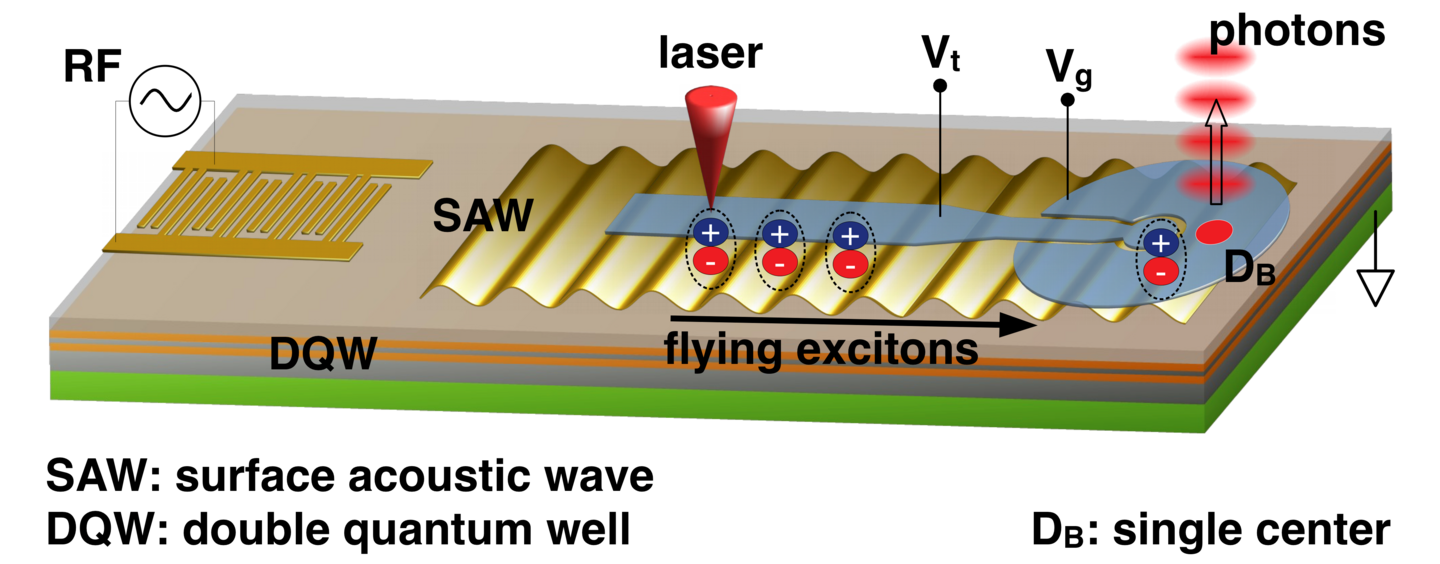“Flying” excitons propelled by GHz surface acoustic waves (SAWs) are outstanding messengers to fulfill these requirements. A main challenge for the implementation of flying excitonic quantum bits is the creation of two-level states for single excitons interconnected by a transport channel, where the particles can be stored, manipulated, and converted to single photons. Recently, researchers at Paul-Drude-Institut and collaborators have realized a major step towards this goal by demonstrating the remote pumping of single-exciton centers by flying indirect excitons propelled by GHz SAWs in a GaAs-based semiconductor platform [1]. Furthermore, the centers can follow the high-frequency (3.5 GHz) acoustic pumping rate, leading to the emission of single photons synchronized with the acoustic phase.
The SAWs used here are mechanical vibrations traveling along the surface of a solid. They can be envisioned as microscopic earthquakes on a chip. The moving deformation caused by the micro earthquake changes the properties of a semiconductor and can create a moving potential to capture and transport excitons - neutral electron-hole pairs bound by the Coulomb force. This unique feature can be exploited for the controlled transfer of information between locations on a chip using “flying” excitons as messengers. The studies were carried out on an epitaxial (Al,Ga)As heterostructure consisting of two GaAs quantum wells separated by a thin barrier. The application of a transverse electric field across the structures creates a special type of exciton – the indirect exciton – consisting of an electron and a hole residing in different quantum wells. The energy and recombination lifetime of these excitons can be tuned by controlling the overlap between the electron and hole wavefunctions using the field. In particular, the lifetime can be made sufficiently long to enable long-range transport by SAWs. The studies showed that indirect excitons could travel over distances exceeding 20 acoustic wavelengths (or equivalently, 16 microns), when propelled along a micron-wide narrow transport channel by a high-frequency (3.5 GHz) SAW.
The flying excitons were then launched to pump a remotely located two-level center for excitons, consisting of a shallow impurity center embedded in the quantum wells (denoted here a DB center). Semiconductors come with many impurities. Some of them can capture and store single excitons: they can thus act as single-photon sources emitting one photon at a time. Different from the everyday light sources found in our household, which generates bunches of photons at a time, the emission of single-photons is non-classical and builds the foundation of photon-based quantum communications. In this work, it was shown that the DB centers can be efficiently populated by flying excitons transported by the high-frequency SAW. More importantly, it was also demonstrated that the pumped DB centers emit single photons at a rate of 3.5 GHz determined by the acoustic frequency, thus becoming one of the fastest so-far realized single-photon sources.
The results demonstrate the feasibility of exciton manipulation as well as of exciton-based, high-frequency single-photon sources driven by acoustic waves. They also pave the way for on-chip transfer of quantum information between different locations with a natural electrical to optical interface. Major advantages of the DB centers are the interconnectivity via a quantum well transport channel as well as the narrow distribution of emission energies (as compared, e.g., to self-assembled semiconductor quantum dots) [2]. They also benefit from the advanced semiconductor processing techniques and can, thus, be conveniently integrated with other electronic and photonic components. In the future, multiple single-exciton centers can potentially be excited by a single SAW beam, thus providing a prospective for scalable arrays of synchronized single-photon emitters.
Paul-Drude-Institut für Festkörperelektronik (PDI), dedicated to device-inspiring research of semiconductors, is a member of the Leibniz Association. This project is supported by the French National Agency (ANR) and Deutsche Forschungsgesellschaft (DFG) in the frame of the International Project on Collaborative Research: Single EIX, Project No. ANR-15-CE24/DFG SA-598-12/1.


